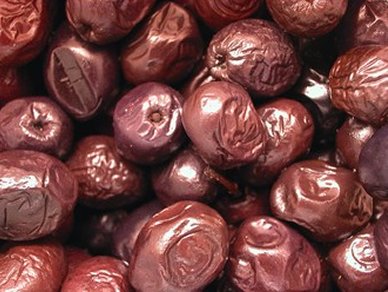One of the oldest methods to cure olives consists of placing the fruit in coarse salt to dehydrate. After 40–60 days of salt dehydration, the olives are washed, dried, and ready to eat. The bitter taste of an olive is generally associated with the presence of the phenolic glucoside oleuropein in the olive flesh. A comparison of dry-salted and raw olives shows that there is a significant lower content of oleuropein in dry-salted olives. Thus, the debittering process must occur during salt dehydration. However, the actual debittering process is still unknown.
Manuel Brenes and colleagues, Instituto de la Grasa, Seville, Spain, discovered that the debittering process is due to an enzymatic oxidation of phenolic compounds and in particular of the bitter glucoside oleuropein. Due to osmotic pressure the tissues of the olives rupture and the phenolic compounds are then in contact with the enzyme polyphenoloxidase. This enzyme catalyzes the oxidation of phenolic compounds. Inactivation of the enzyme by pasteurization prevents the oxidation and higher amounts of polyphenols are found in the brine of pasteurized olives. The elucidation of the enzymatic pathway for the debittering of dry-salted olives opens up the possibility to optimize this reaction.
The researchers recommend a ratio of salt/olives of 0.4 to give a high concentration of salt in the juice of the dehydrated olives. This high salt concentration is needed for the chemical and microbial stability of the dry-salted olives.
- Debittering of black dry-salted olives,
Eva Ramírez, Pedro García-García, Antonio de Castro, Concepción Romero, Manuel Brenes,
Eur. J. Lipid Sci. Technol. 2013.
DOI: 10.1002/ejlt.201300167




